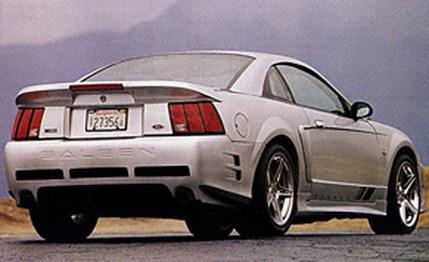
 Specialty File
Specialty File
Saleen Mustangs are unabashed mutants, with bodywork additions that bulge like the lats on Mr. Universe contestants, with wheels and tires that crowd the wheel housings, and with engines that pulse with supercharged steroids.
Of course, they`ve also displayed some of the downsides of steroid abuse in the past, such as grumpy idling, supercharger whine, a jolting ride, and tramlining on longitudinal grooves badly enough to make a bloodhound dizzy. Also, under the duress of our testing procedures, some examples of Saleen's handiwork have even, uh, failed to go forward.
But this S281 you see here seems a zebra of an altogether different stripe. Using the overhead-cam 4.6-liter V-8 as a base, and employing a Roots-type Saleen supercharger much quieter than the one we last sampled on Saleen's S351R (C/D, December 1996), the 2000 S281 is comparatively civilized in nature.
It starts easily and idles smoothly. Although the 2.5-inch-diameter stainless-steel exhaust system utters a note clearly deeper and gruffer than you hear on the stock Ford. it avoids being obnoxiously boomy. especially at low rpm. where this problem often turns up on after market pipes.
The clutch effort is reasonable, and the short-throw shifter that Saleen bolts on works quite well, particularly when you hear in mind that the standard five-speed tranny isn't the slickest in the business anyway. Low and midrange torque are excellent, providing bright throttle response in almost any gear. You can leave the traffic for dead without breaking a sweat, but the S281 engine will also zip through to its 6000-rpm redline with no sign of reluctance along the way. Perhaps this is what you'd expect from the over head-cam engine, but it's undoubtedly helped here by Saleen's cast-aluminum intake manifold and high-flow (24 pounds per hour) fuel injectors--all managed by custom fuel-delivery calibrations.
The last supercharged Saleen we tested (C/D, August 1998) suffered from the lack of an intercooler, but the S281 takes no chances here and wears an air-to-water intercooler squeezed into the engine bay. Saleen claims 350 horsepower for the ear in this form, up 90 hp from the stock GT's 260, and 65 more than Saleen's own naturally aspirated S281.
That's a colossal jump, and although the car feels significantly stronger on the road, our test results don't provide hard support for those horsepower numbers. Yes, our quarter-mile time of 13.8 seconds at 103 mph is quite a bit quicker than a stock Mustang GT's 14.2 at 98, but is it evidence of 350 horsepower? Not really. Saleen's publicity material quotes some performance figures published by another magazine, declaring it went from 0 to 60 mph in 4.8 seconds and turned the standing quarter in 13.4 seconds at 108 mph.
We guessed these might have been simple one-way runs, perhaps without weather correction. But when we looked more closely at the numbers, we discovered that our launches were better, with fractionally quicker times to 30 and 40 mph.
Since the supercharged S281 has to be bogged off the line (the clutch must be engaged at low revs to avoid time-wasting wheel-spin), this performance disparity thus appears to be a pure power issue. Even more telling is the performance of our own supercharged--but not intercooled--project Mustang GT (C/D, July 1999). We measured 278 rear-wheel horsepower on a dyno, which translates into about 330 crankshaft horsepower. That car--with 20 less hp and about 150 fewer pounds than the Saleen car--hit 60 mph in 4.9 seconds and blew through the quarter-mile in 13.6 seconds at 103 mph. Perhaps this S281 was just a slow example--who knows?
A pretty fair increase in power is evident at higher speeds. The S281 reaches 100 mph 2.1 seconds quicker than the GT. And more convincing yet is the dash to 130 mph--it's a full 13.5 seconds quicker. The supercharged engine also has the grunt to tow the spoiler-festooned S281 to a top speed of 154 mph, beating the stock GT by 16 mph. Given the extra spoilers and scoops, that velocity increase makes the 350-hp claim more credible.